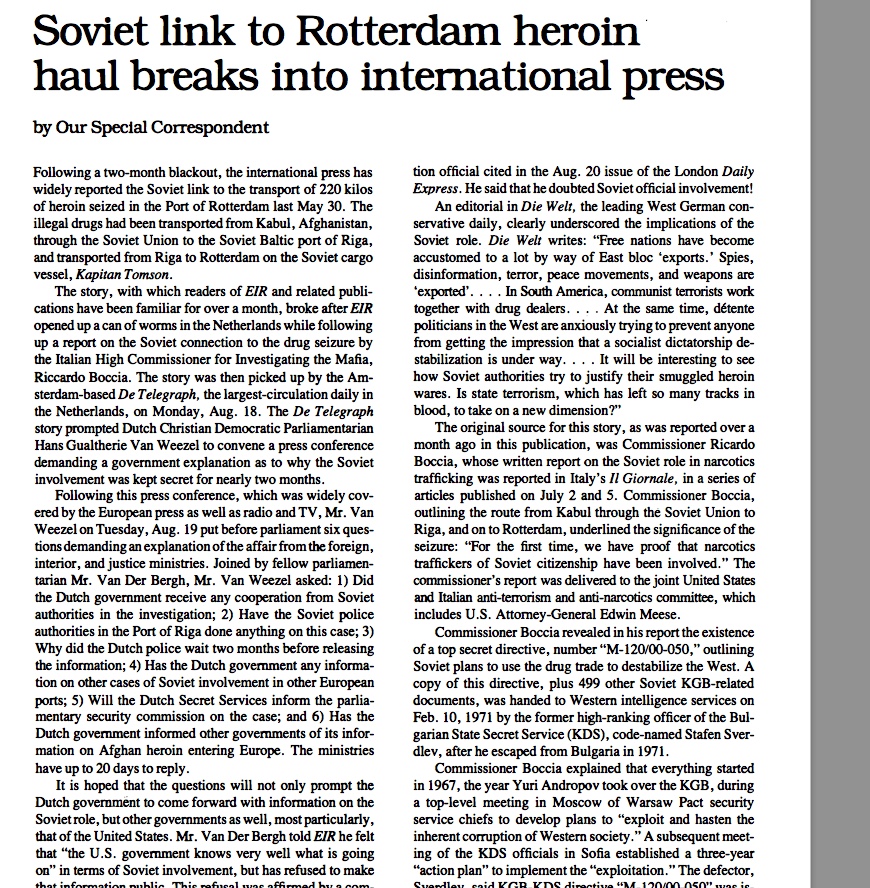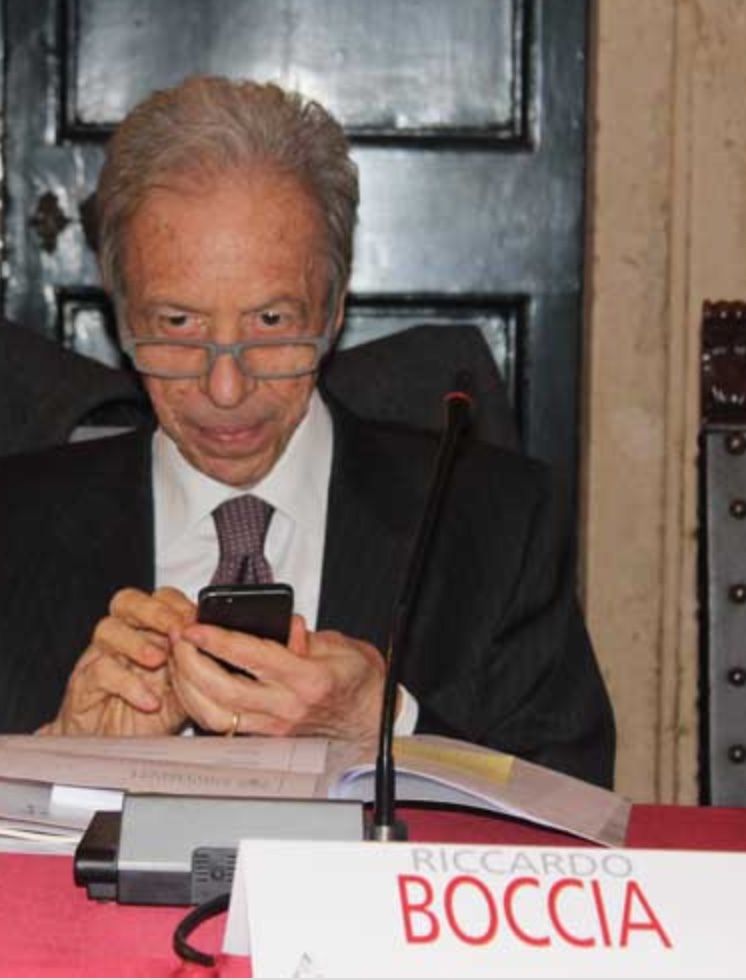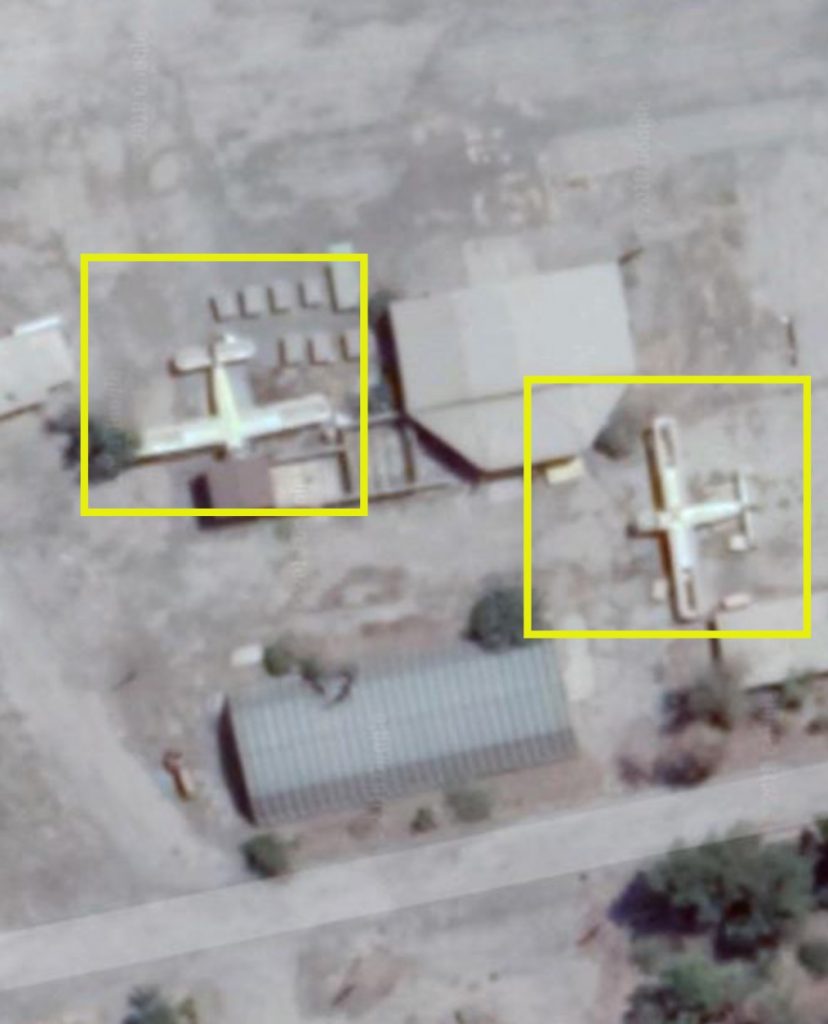May 27, 1986, in the Dutch port of Rotterdam, the Soviet cargo ship Kapitan Tomson, coming from Soviet Baltic port of Riga, steered for its berth at the Unitcenter dock in the Waalhaven section of the harbor (Executive Intelligence Review, Volume 13, Number 34, August 29, 1986).
The ship had made this journey many times, attracting little notice, except from the merchants and businessmen awaiting their freight. The Narcotics Squad of Rotterdam’s harbor police found, that two containers the stevedores would remove had papers showing that they contained raisins. But among their contents, the police” found at least 220 kilos of heroin that had come from Soviet- occupied Afghanistan.
From Afghanistan, the heroin had traveled through the Soviet Union to the Baltic port of Riga, where it was placed aboard of Kapitan Tomson. The Soviet origin of the ship was never mentioned in the Dutch or any other press.

The hardest evidence of Soviet involvement in narcotics trade came out until a German magazine Krieg dem Rauschgft (War on Drugs), stirred up a hornet’s nest in the Netherlands, while following up a report issued by Italian Commissioner for Investigating Mafia, Ricardo Boccia, on the Soviet connection to this drug seizure.
The story was then picked up by the Amsterdam De Telegraph, the largest-circulation daily in the Netherlands, Aug. 18. The appearance of this story then prompted Dutch Cristian Democratic parliamentarians Hans Gualtherie van Weezel and Dr. van der Bergh to submit a series of parliamentary interrogatives, demanding to know why information was withheld from the public, and calling for the government to come forward whatever information it had about Soviet involvement in the drug trafficking in the Netherlands, as well in other Western European countries.
But no international inquiry has been called. And few journalists have deemed the incident a subject worthy of “investigative journalism.” Dutch police have told the press that they have no Soviet citizens under investigation, nor do they suspect any Soviet involvement in the heroin shipment, claiming the shipping containers had been sealed in Afghanistan by the smugglers without the knowledge of Soviet authorities. There was enough information to trace the Kapitan Tomson directly to Soviet secret intelligence services.
The story began in the sparsely populated mountains of Afghanistan, a region that forms, together with its neighbors Pakistan and Iran, the so-called Golden Crescent, the source of hundreds of kilos of heroin in that end up in Western Europe and the United States.

The Soviet Union had 125,000 troops in Afghanistan, who had been conducting a Vietnam-style war of attrition against stubborn mountain tribesmen. It was reported by investigative journalists that these same tribes resisting Soviets are responsible for opium trafficking into Pakistan, where it was refined into heroin or morphine base and shipped out via Karachi, or via a complex overland route through Iran and Turkey, then to Bulgaria into Italy, or into North Europe on Bulgarian TIR rucks. The maps of the hills and valleys of the opium- growing regions along the Hilmend and Kuna rivers, show that these areas were deep inside the lines of the Soviet mechanized rifle divisions, and, in some cases, these areas border the Soviet Union itself. The 1979–1989 Soviet occupation crippled the Afghan economy and created an environment where illicit activity and criminal networks nourished. The war devastated the Afghan countryside, destroying irrigated land and smothering agricultural output. Millions of Afghans fled the country, while many who remained turned to poppy cultivation, since poppies required little water and could grow in poor agricultural conditions.38 From 1984 to 1985, Afghan opium production was estimated to more than double, from 140 to 400 metric tons, and in 1986, doubled again.
The Rotterdam police who have investigated the Kapitan Tomson case claimed that everything was handled by Soviet state transport companies, since no foreign transport companies were allowed to operate inside the Soviet Union. Moreover,within Afghanistan, all commercial shipments by rail or truck were guarded by the Soviet military, or if freighted, flown on military aircraft.
Freight shipped through the Soviet Union from Afghanistan, had to pass through Leningrad where it was put onto cargo ships and directly expedited to Rotterdam. And, according to Lloyds Ship Information, the Kapitan Tomson had already been on a route that took it from the European ports of Riga, London, Rotterdam, and Aarhus, northern Denmark, to the Greek of Piraeus, the Syrian port of Latakia, to Beirut and the Turkish ports of Mersin, Iskenderun, as well as the Cypriot port of Limassol. The route corresponded with one of the most notorious guns-for drugs routes known by security experts.
There weren’t fingerprints to prove official Soviet involvement, since no Western drug-enforcement agency has a liaison with Soviet authorities, but we do possess a motive for Soviet involvement – the destabilization of the “decadent West, “commentator Peter Gillies of the conservative West German newspaper Die Welt wrote in August 1986:
Free nations have become accustomed to a lot in the way of East bloc “exports”: Spies, disinformation, terrorism, peace movements, and weapons are “exported”….In South America, communist terrorists work together with drug dealers….At the same time, pro-détente politicians in the West were anxiously trying to prevent anyone from getting the impression that a destabilization led by a dictatorship is under way…. It will be interesting to see how Soviet authorities try to justify their smuggled heroin wares. Is state terrorism, which has left so many tracks in blood, to take on a new dimension?”
Riccardo Boccia, Italian High Commissioner for Investigating the Mafia, was the first to publicly reveal Soviet involvement in the Rotterdam case when, in early July 1986, he released a report before a joint U.S.-Italian anti-terror and anti-narcotics commission that included U. S. Attorney General Edwin Meese.

Boccia made a very clear case for Soviet involvement, revealing not only that “for the first time, we have proof that drug traffickers of Soviet citizenship “were involved, but so the existence of a top-secret KGB directive M-120/00-050,outlining Soviet plans to use the drug trade to destabilize the West (more than $8 billion spent by the United States alone to fight heroin drug-trade over the years).
).A copy of this directive, plus 399 other Soviet KGB related documents, was handed over to Western intelligence services on Feb. 10, 1971, by a former high-ranking officer of the Bulgarian Secret Services, codenamed Stefan Svedlev, after he escaped from Bulgaria in 1971.
Commissioner Boccia explained that the Soviet drug war started in 1967, the year Yuri Andropov took over the KGB, at a meeting in Moscow of the Warsaw Pact Security Service chiefs, whose purpose was to develop plans to “exploit and hasten the inherent corruption of Western society.”
A subsequent meeting of Bulgarian Secret Service officials in Sofia, Bulgaria established a three-year “action plan” to implement the “exploitation. “Defector “Svedlev” said that Directive M-120/00-050 was issued in June 1970, in assessing the progress of the plan to “destabilize Western society through …the narcotics trade.”
According to a report from the U.S. Drug Enforcement Administration (DEA), Bulgarian government’s export-import agency Kintex, founded in 1968, was the KGB-directed “umbrella organization which orchestrates the trafficking of narcotics and weapons smuggling through Bulgaria.” Kintex was involved in the big Stipam arms-for-drugs bust in Milan on Nov.23, 1982. The Stipam case provided a map of the intersection of anarchist/leftist and neo-Nazi terrorism, Iranian gun-running, and drug traffic into Western Europe.
A key link in the chain of the Rotterdam case was Transworld Marine Agency Company, the Benelux shipping agent of the Kapitan Tomson and agent responsible for delivery of two containers from Afghanistan to Rotterdam. Transworld Marine links Soviet state shipping companies to leading trade interests in Antwerp, Rotterdam, and Amsterdam, European’s most cosmopolitan and wealthiest ports.
The workings of this company will reveal the other motivation for the drug trafficking: the prospect of wealth and the power that such wealth provides.
Transworld Marine also appears to service the needs of Soviet intelligence, since at leastthree employees of Transworld Marine and other Soviet companies in Belgium were expelled for espionage in the 1970s.
Niklas Swanstrom heads the program for Contemporary Silk Road Studies at Sweden’s Uppsala University in May, 2004 said:”We’ve seen evidence that the Russian military, and at a high level, has been involved in the Central Asian drug trade.”
In 200, a former Russian military intelligence officer said such shipments were common practice — and that up to 100 senior officers were involved in the drug trade.
“We’ve seen evidence that the Russian military, and at a high level, has been involved in the Central Asian drug trade, if not by any other factor [than] by the size of this transport from Central Asia through Russia or the former Soviet Union,” he said. “It can only be transported by trucks, private planes, or military aircraft — and military aircraft seems to be a big factor in this. And that can only be organized by senior officers.”
The Kremlin has brought the Soviet-West confrontation policy for the sake of strengthening its own power back to life, consequently, M-120/00-050 directive was possibly returned.
Given the expanding influence of Russia in the Middle East-Central Asian region, the creation of military bases in Syria, the strengthening of ties with the Taliban, the documenting of Russian special services’ involvement in the supply of large quantities of drugs, such Soviet-era operations are substantially probable.
Russia’s desire to legalize the Taliban in Afghanistan as a recognized actor in charge of state governance is presumably associated not only with a security factor, but with the ability to take full control of heroin exports from Afghanistan.
In 2016, Resolute Support and USFOR-A commander General John Nicholson said that approximately 60 percent of Taliban funding came from the drug trade.Nicholson, “Department of Defense Press Briefing by General Nicholson in the Pentagon Brie ng Room,” December 2, 2016.
In 2018, DOD pointed out that given the increase in levels of cultivation and production in recent years, and the lucrative nature of the narcotics trade, “it’s plausible the Taliban now place greater emphasis on narcotics as a primary source of revenue.”(DOD, email to SIGAR, March 13, 2018.) An estimated annual export value of $1.5 to $3 billion in recent years. In 2017, poppy cultivation alone was estimated to provide up to 590,000 full-time-equivalent jobs, more than the number of people employed by the Afghan National Defense and Security Forces (ANDSF).
Afghanistan has consistently produced about 85 percent of the world’s opium. . During King Mohammed Zahir Shah’s reign from 1933 to 1973, the ruling family controlled the Afghan opium trade and largely exported it to Iran.
Having studied the RF support for the Afghan Taliban, it is possible to link their arms supply to the Russian base in Tajikistan. A study of the Qurgonteppa airfield satellite images demonstrates the presence of several small aircraft located near the military transport sides of the Russian Aerospace Forces.

This type of aircraft is used to transport heroin.
Thus, we are talking about the northern route for the delivery of heroin to Western Europe.

“The Northern Route”: Afghanistan -> Central Asia -> Russia -> Western Europe (Heroin, 95 metric tons)The largest national market for Afghan heroin is the Russian Federation, and that market has rapidly expanded since the dissolution of the Soviet Union. Reports indicate that Russia is there heroin is now doing its worst damage, including through the spread of HIV.
Consequently, the Armed Forces of the Russian Federation led by the RF military intelligence may have a hand and part in the supply of heroin to Western Europe, as well as in controlling the supply of heroin to Russia itself.






